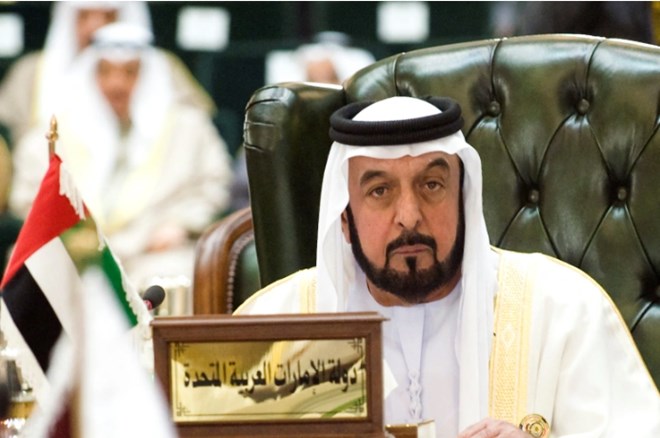
Friday May 13, 2022

United Arab Emirates President Sheikh Khalifa bin Zayed Al
Nahyan has died, Emirati state news agency WAM reported. He was 73.
“The Ministry of Presidential Affairs announced that there
will be 40 days of official mourning with flags at half mast and three days
closure of ministries and official entities at the federal and local levels and
the private sector,” the agency wrote on Twitter on Friday.
Sheikh Khalifa had rarely been seen in public since
suffering a stroke in 2014, with his brother, Abu Dhabi’s Crown Prince Mohammed
bin Zayed (known as MBZ) seen as the de facto ruler and the decision-maker of
major foreign policy decisions, such as joining a Saudi-led war in Yemen and
spearheading an embargo on neighbouring Qatar in recent years.
“The UAE has lost its righteous son and leader of the
’empowerment phase’ and guardian of its blessed journey,” MBZ said on Twitter,
praising Khalifa’s wisdom and generosity.
Under the constitution, Vice President and Prime Minister
Sheikh Mohammed bin Rashid Al Maktoum, the ruler of Dubai, would act as
president until the federal council which groups the rulers of the seven
emirates meets within 30 days to elect a new president.
Condolences started pouring in from Arab leaders, including
Bahrain’s king, Egypt’s president and Iraq’s prime minister.
US Secretary of State Antony Blinken conveyed his
condolences on the death of Sheikh Khalifa, whom he described as “a true friend
of the United States”.
“We deeply valued his support in building the extraordinary
partnership our countries enjoy today. We mourn his passing, honour his legacy,
and remain committed to our steadfast friendship and cooperation with the
United Arab Emirates,” he said.
Sheikh Khalifa came to power in 2004 in the richest emirate
Abu Dhabi and became the head of state. He is expected to be succeeded as ruler
of Abu Dhabi by Crown Prince Sheikh Mohammed.
Abu Dhabi, which holds most of the Gulf state’s oil wealth,
has held the presidency since the founding of the UAE federation by Sheikh
Khalifa’s father, the late Sheikh Zayed bin Sultan Al Nahyan, in 1971.
Sheikh Khalifa’s rule
Sheikh Khalifa was born in 1948 in the inland oasis of
al-Ain, near the border with the Sultanate of Oman, and named after his great
grandfather, Sheikh Khalifa bin Shakhbout.
In 1969, while the area was still a British protectorate,
Khalifa was named Abu Dhabi’s prime minister and chairman of the emirate’s
Department of Defence, which later became the core of the UAE’s armed forces.
After independence in 1971, he became defence minister along with other roles
and became president in 2004.
Although the UAE’s ruling sheikhs hold near-absolute power,
Sheikh Khalifa began an experiment with elections by allowing limited voting –
by a hand-picked electorate – for half the members of a 40-seat federal
advisory body in 2006. Subsequent rounds of elections in 2011 and 2015 failed
to attract even two out of five of those given a chance to vote.
The UAE saw none of the Arab Spring street protests that
shook other parts of the region, though, in the wake of that unrest, Khalifa
oversaw tightening crackdowns on opposition activists, drawing criticism from
international rights groups. The UAE also supported efforts in the region to
quash the Muslim Brotherhood, including in Egypt.
Sheikh Khalifa increasingly used Abu Dhabi’s oil wealth to
attract cultural and academic centres, such as branches of the Louvre Museum
and satellite campuses of New York University and the Sorbonne. He also
presided over efforts to move the OPEC country beyond its reliance on
petrodollars with investments in renewable energy research, including plans for
a futuristic low-carbon desert city known as Masdar.
Abu Dhabi’s big spending overseas during Sheikh Khalifa’s
rule also helped push the emirate, which controls the bulk of the UAE’s oil
reserves, out from the shadow of Dubai, the Middle Eastern commercial hub.
As Dubai’s fortunes began to falter along with the global
economy in 2009, Sheikh Khalifa led efforts to protect the federation by
pumping billions of dollars in emergency bailout funds into Dubai. The two
emirates do not always see eye-to-eye on foreign policy decisions and compete
commercially with one another. In 2003, he called for the creation of a new
airline, Etihad Airways, which competes with Dubai’s successful and much larger
carrier Emirates Air.
Sheikh Khalifa also helped boost the UAE’s regional profile
with relief missions to Pakistan after devastating floods and by sending
warplanes to the NATO-led mission against Muammar Gaddafi’s rule in Libya in
2011.
Questions were raised during Sheikh Khalifa’s rule about the
UAE’s use of foreign military contractors, including one linked to the founder
of the former Blackwater security firm, Erik Prince, who moved to Abu Dhabi in
2009. Prince was involved in a multimillion-dollar programme to train troops to
fight pirates in Somalia, according to an official who spoke to The Associated
Press news agency in early 2009.
Sheikh Khalifa’s name is perhaps most familiar around the
world for its connection to the world’s tallest building, a nearly 828-metre
(half-a-mile) glass-and-steel spire in Dubai.
The name of the tower was unexpectedly switched from the
Burj Dubai to the Burj Khalifa at its official opening in January 2010
following his decision to funnel billions of dollars to Dubai to save it from a
full-scale financial meltdown.
He was believed to be among the world’s richest rulers with
a personal fortune estimated by Forbes magazine in 2008 at $19bn.
He is known to have had eight children – two sons and six
daughters – with his first wife, Sheikha Shamsa bint Suhail Al Mazrouei. He is
also survived by several grandchildren.